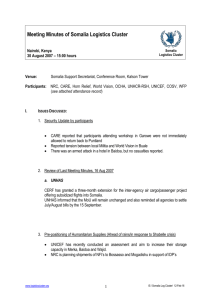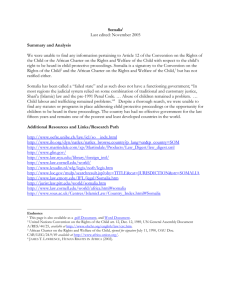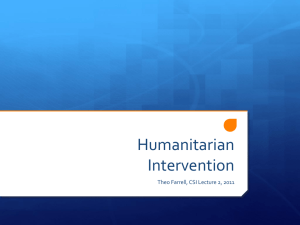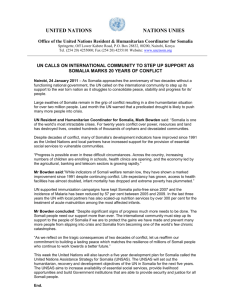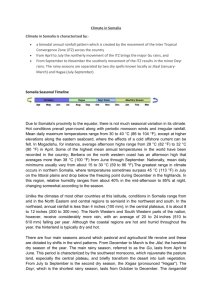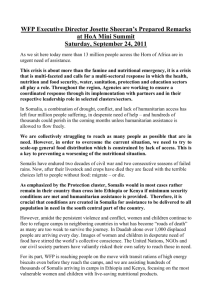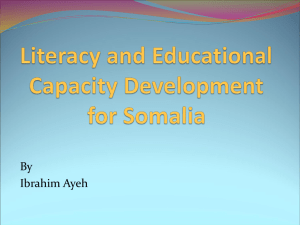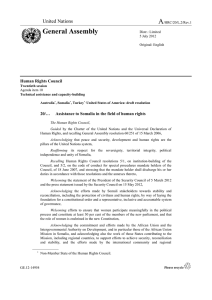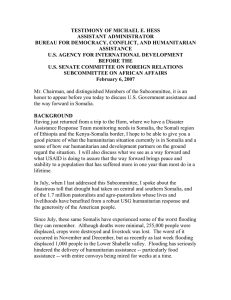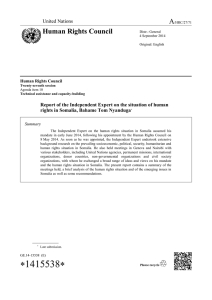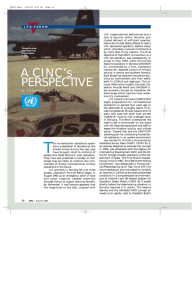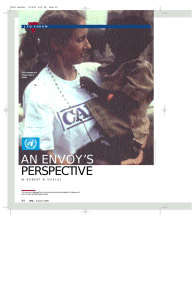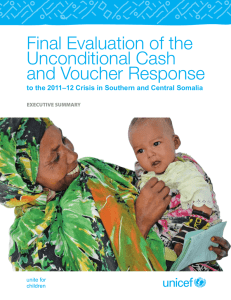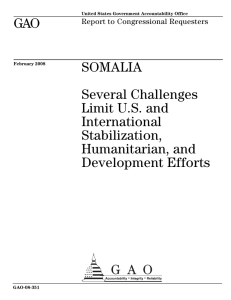TESTIMONY OF MICHAEL E. HESS ASSISTANT ADMINISTRATOR
advertisement
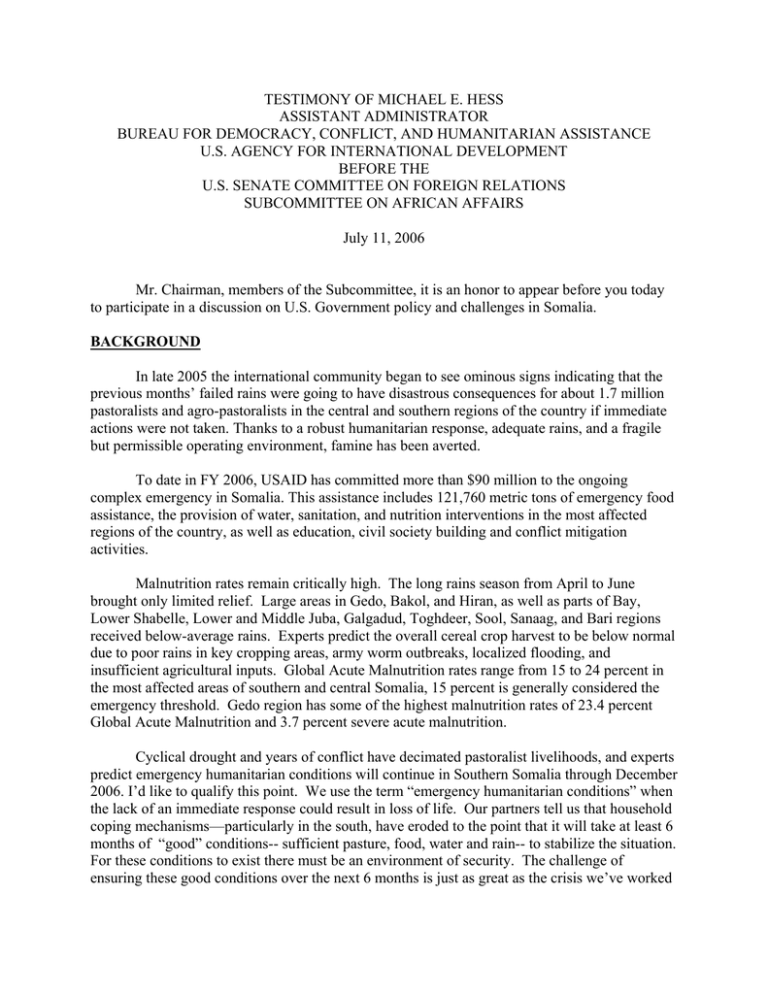
TESTIMONY OF MICHAEL E. HESS ASSISTANT ADMINISTRATOR BUREAU FOR DEMOCRACY, CONFLICT, AND HUMANITARIAN ASSISTANCE U.S. AGENCY FOR INTERNATIONAL DEVELOPMENT BEFORE THE U.S. SENATE COMMITTEE ON FOREIGN RELATIONS SUBCOMMITTEE ON AFRICAN AFFAIRS July 11, 2006 Mr. Chairman, members of the Subcommittee, it is an honor to appear before you today to participate in a discussion on U.S. Government policy and challenges in Somalia. BACKGROUND In late 2005 the international community began to see ominous signs indicating that the previous months’ failed rains were going to have disastrous consequences for about 1.7 million pastoralists and agro-pastoralists in the central and southern regions of the country if immediate actions were not taken. Thanks to a robust humanitarian response, adequate rains, and a fragile but permissible operating environment, famine has been averted. To date in FY 2006, USAID has committed more than $90 million to the ongoing complex emergency in Somalia. This assistance includes 121,760 metric tons of emergency food assistance, the provision of water, sanitation, and nutrition interventions in the most affected regions of the country, as well as education, civil society building and conflict mitigation activities. Malnutrition rates remain critically high. The long rains season from April to June brought only limited relief. Large areas in Gedo, Bakol, and Hiran, as well as parts of Bay, Lower Shabelle, Lower and Middle Juba, Galgadud, Toghdeer, Sool, Sanaag, and Bari regions received below-average rains. Experts predict the overall cereal crop harvest to be below normal due to poor rains in key cropping areas, army worm outbreaks, localized flooding, and insufficient agricultural inputs. Global Acute Malnutrition rates range from 15 to 24 percent in the most affected areas of southern and central Somalia, 15 percent is generally considered the emergency threshold. Gedo region has some of the highest malnutrition rates of 23.4 percent Global Acute Malnutrition and 3.7 percent severe acute malnutrition. Cyclical drought and years of conflict have decimated pastoralist livelihoods, and experts predict emergency humanitarian conditions will continue in Southern Somalia through December 2006. I’d like to qualify this point. We use the term “emergency humanitarian conditions” when the lack of an immediate response could result in loss of life. Our partners tell us that household coping mechanisms—particularly in the south, have eroded to the point that it will take at least 6 months of “good” conditions-- sufficient pasture, food, water and rain-- to stabilize the situation. For these conditions to exist there must be an environment of security. The challenge of ensuring these good conditions over the next 6 months is just as great as the crisis we’ve worked so hard to avert. We can’t do much to ensure that the October rains succeed, but we can work to increase the scope of our assistance, and to support efforts to establish a stable, secure, environment in which recovery may occur. I’d like to stress this point: “Stabilizing the situation” means that the population is no longer at immediate risk, but it does not mean a more complete recovery-- or a return to “normal”. In fact, it is not obvious that there is truly the possibility of such a return. Traditionally, after a severe loss of animals—like the 50%-80% of herd loss we have witnessed this year-- it could take a pastoralist community six to seven years to re-establish herds. However, with increasing variance in rain cycles, as well as increasing environmental degradation, this longer-term recovery is far from certain. In addition, ongoing insecurity and lack of rule-of-law perpetuate an environment of risk and work against household and community attempts at recovery. The desperate need to acquire livestock—in the face of severe depletion of household assets—will translate into conflict between clans and individuals, and will increase strain on the volatile network of alliances that constitutes order in this society. Nowhere else in the Horn of Africa are destitution and competition for scarce resources more obvious drivers of conflict. To improve the lives of Somalia’s pastoralists and agro-pastoralists in a sustainable way requires -- like in northern Kenya and southern Ethiopia—roads, markets, trade… and above all else, good governance. Somalia is a ways away from being able to absorb this kind of assistance—but I feel it is important to emphasize that there is nothing short-term about the vulnerability that underlies the current humanitarian situation, and that until the space exists to address this vulnerability, I believe we will see hunger and security crises occurring at ever shorter intervals in Somalia. ACCESS To continue life saving activities, aid agencies must be able to ensure delivery of humanitarian assistance to all areas of need, regardless of who is in control. Their careful planning and engagement in Somalia--both formal and informal—has resulted in tremendous success in getting aid to those who need it. Early in this response there were several pirate attacks on food shipments coming into the ports and on truck convoys coming over the Kenyan border. Neither threat, however, has turned out to have a decisive impact on aid. More recently, inland access throughout Somalia has improved following the end of fighting between Somali warlords and the Union of Islamic Courts (UIC), which was recently renamed the Somali Supreme Islamic Courts Council (SSICC). Aid agencies report the UIC/SSICC has removed most road blocks, resulting in a more stable operating environment and reduced transportation costs. Nevertheless, pockets of insecurity remain a major concern. On July 3, in the Lower Juba region, a World Food Program (WFP) convoy escorted by armed men of one militia was attacked by a rival militia, apparently unhappy about not being awarded the private security contract to escort the convoy. Three people, all combatants, were killed in the skirmish. No food was looted, and the convoy was diverted to a nearby village until a compromise was reached. This is just one example of the complexity and danger of operating in southern Somalia. IMPACT of CONFLICT We know from the past few months that if fighting breaks out again in southern Somalia, displacement will be significant—both inside Somalia and out of the country. Any internal displacement risks destabilizing the fragile process of recovery for most communities in the south, and places the lives of the most vulnerable at risk. USAID is working closely with our partners to develop contingency plans for widespread displacement; however, conflict greatly increases the difficulty of negotiating the access upon which the delivery of humanitarian assistance depends. USAID STRATEGY: For now the provision of emergency assistance to vulnerable Somalis affected by the recent drought and the evolving conflict will continue to be the primary focus of USAID activities. Through Title II support to the food distribution programs implemented by the World Food Program and CARE International, the USG is currently meeting 40-50% of all emergency food aid needs in Somalia, which currently are near 23,000 MT per month. The recently approved Supplemental will enable us to maintain this level of support over the next critical months. Just as important, we support nutritional surveillance throughout the country, and bring specialized nutrition interventions and life saving vaccinations to Somali children in their communities. Our emergency programs incorporate small scale livelihood activities, and our water interventions are designed to build local capacity to manage this scarce resource and to mitigate water-related conflicts. With Development Assistance allocations of over $5 million in both FY 2005 and FY 2006, our partners have begun implementing a number of activities aimed at building civil society, mitigating conflict, providing access to drinking water, and improving access and quality of basic education through interactive radio programming. The recently launched education radio program is already having an impact in Somalia. I heard about 8 year old Najmo who couldn't attend school during the recent fighting in Mogadishu. However, because of her school’s participation in the radio education broadcast, she was able to tune into the radio education program and continue her lessons from home. We will use part of the FY 2006 International Disaster and Famine Assistance funds identified for famine prevention and mitigation to build on both our emergency and our development assistance funded activities—expanding our use of radio, developing community health and veterinary services, and helping to rebuild livelihoods. My staff is doing everything it can to increase our access to reliable and timely information. We continue to work with our partners to improve and expand reporting. We are also discussing the establishment of an independent monitoring unit capable of identifying gaps and weaknesses in our humanitarian response. In closing, I appreciate the opportunity to talk to you today about our work. As you know, I was not able to visit Somalia during my recent trip to the region, but I talked to people at the border in Kenya, and I saw the conditions there and in the Somali region of neighboring Ethiopia. These are strong people who have suffered much, and they appreciate what we are doing for them. We’ve done our best, and we will continue to do our best, to anticipate and deliver the assistance they need, to strengthen local capacities and community resilience, and to plan for sustainable gains, even as we continue to meet emergency needs. Thank you again.
